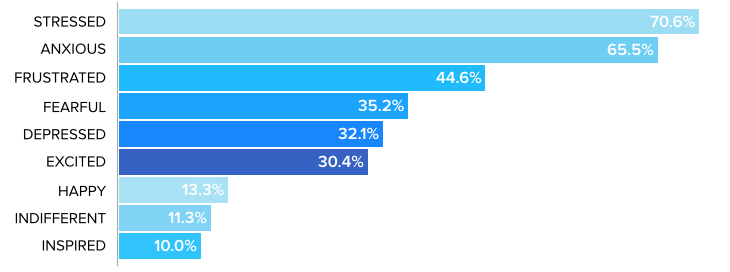It is easy to discredit the stress, negativity and futility young people express toward high school, especially when we look back on our own lives and our own school experiences. In comparison to the responsibilities of adult life, being a teenager sounds like a carefree dream. We find ourselves thinking ‘come on kids, it’s not that bad’. But are rose-tinted glasses filtering our collective memory of the stress and anxiety associated with adolescence?
If we compound the natural stress that arises from exams with the current state of education, employment and post-school opportunities for young people, you have a far more serious situation. Currently, our high school students are facing:
- increased pressure to perform well in the ATAR
- more precarious career prospects due to the increased threats of automation and outsourcing
- decreasing job stability
- a housing crisis that the media loves to remind them of
- and a frightening amount of mental health issues
As part of a research paper powered by YouthSense and Year13 – After The ATAR: Understanding How Gen Z Transition into Further Education and Employment – we asked students how they felt about Year 12. The results, on the whole, were a bit of a wakeup call. In the graph below, the highest positive emotion is ‘excited’, but that comes after ‘stressed’, ‘anxious’, ‘frustrated’, ‘fearful’ and ‘depressed’, respectively. The ‘excitement’ is probably fuelled by the prospect of finishing high school and being relieved of these negative emotions, rather than bracing for the possibilities of the future.
Providing uplifting, optimistic and affirmative content to young people is often necessary in order to create a positive brand image, but it can also seem inauthentic and unrelatable. The youth audience is feeling anything but positive, and when brands, education providers and government organisations fail to recognise this, young people can become disengaged with their messages.
Rather than dismissing the trials and tribulations that young people are facing (which will ostracise the youth audience), these adversities need to be acknowledged and validated through content.
It is important to note that this approach can easily lead to condescension. Patronising the youth audience through content that is inauthentic will alienate Gen Z and create disdain for your brand. Token gestures that are built on irrelevant or outdated notions of what high school is, or what the teenage experience should be like, will always be ineffective in establishing a youth following.
So, what can we do? How can we make our voice more authentic and relatable?
Work closely with young people
At Year13, hiring high school students or recent Year 12 graduates is a top priority to ensure that our youth voice is honest, authentic and relatable.
Year13’s most recent hire, Emma, completed her first year of university before discontinuing her studies. At 18 she was overwhelmed with trying to navigate her post-school options and was part of the 45% of young people who don’t know what they want to do after school. Despite her confusion, her drive and commitment allowed her to become a valuable company asset and provide an authentic youth voice that resonates with Year13’s target audience. Emma now manages the content across the Year13 platform.
The article below, We Just Stopped Talking, was written by Emma and published to the Year13 site. It was highly successful and draws on negative feelings and experiences of social isolation and exclusion between young people as they navigate high school. The article’s success lies in its acknowledgement of the feelings and genuine experiences of teenagers, without discrediting them.
Use memes
Memes are a perfect example of utilising negative emotions to engage youth. Memes create authenticity and instant gratification to a youth audience. Using this content allows your brand to tap into popular culture in a relatable and shareable way that can help align a business to a youth voice.
Successful memes are often self-referential and based on self-deprecation (a brand of humour that is prevalent within teen culture), which is what makes them so relatable. The struggles of students are often mirrored across the country and, as a result, viral memes relating to school age individuals often draw on collective struggles regarding procrastination, self-loathing and issues relating to anxiety, depression and social exclusion. With 51% of respondents to YouthSense and Year13’s research identifying a need to see a mental health professional, young people are aware of and acknowledge the negative emotions that they are grappling with.
The negative nature of this content allows teenagers to feel like they are not alone when they face challenges. Memes tend to diverge from the perfect, Pleasantville life that is portrayed through popular media, which is what young people can relate to. Below is an example of a self-deprecating meme posted to Year13’s social channels. It was highly successful and draws on the above-mentioned struggles of young people as they transition through high school.
Use youthful imagery
Youthful brand imagery is also important and can draw on negative emotions in order to engage young people. The following images have been used alongside Year13 articles and exemplify the growing trend toward drawing on negative emotion to engage youth.
Each of these images are inherently negative. In some ways, they also romanticise the stresses and frustrations of being a teenager. By harnessing this, we can align with young people, then better equip them with tools and resources to improve their mental health, education and employment opportunities, and more.
What can be learned from this?
Shying away from negative content runs the risk of seeming inauthentic. Although it can seem daunting to address the topics of stress, perceived futility, anxiety, depression and general negativity, these factors simply must be addressed. Responding to youth trends, such as the ones that have been evidenced in the After The ATAR report, can assist in creating engaging content for young people.











